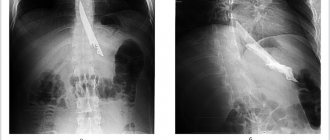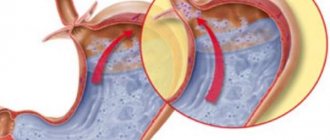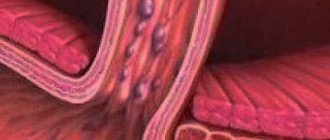An unpleasant and frightening symptom for many is the feeling of a lump in the esophagus. Such a clinical manifestation makes a person suspect the development of various diseases. The difficulty is that it is completely unclear which doctor should be contacted with this problem. Similar symptoms occur in a number of pathologies that can be treated.
Features of symptoms
The condition when a lump appears in the throat was described in the works of the world-famous Hippocrates. In his opinion, such a symptom is characteristic of people with very excessive emotionality. Now the idea of this has changed somewhat.
Main signs of symptoms:
- difficulties in swallowing and breathing;
- feeling that there is a foreign body in the esophagus;
- a persistent desire to cough or swallow a clearly felt lump;
- suffocation and feeling that there is not enough air;
- fear of choking or suffocation;
- hoarse voice;
- pain when talking or eating.
Such unpleasant sensations can appear only periodically or be observed on an ongoing basis.
Discomfort in the esophagus as a result of stress
The phrase “I got a lump in my throat from the experience” has a physiological basis. With strong emotions, both negative and positive, a spasm of the muscles of the larynx, pharynx, and upper part of the esophagus occurs. This results in a feeling of lack of air and an unpleasant sensation of a lump in the esophagus.
In emotionally stable people, such phenomena are short-lived, pass quickly and without consequences. Long-term persistence of symptoms is observed:
- in people of the neurasthenic type, prone to frequent mood swings;
- in childhood during prolonged stressful situations (quarrels between parents, divorce, change of place of residence or study, exams);
- in women during pregnancy or menopause;
- when working with increased attention and responsibility.
In this case, the following help to get rid of a lump in the throat: walks in the fresh air, psychotherapeutic assistance, taking light sedatives, a change of environment.
Feeling of a lump when swallowing saliva
The feeling of a lump, which is clearly felt when swallowing saliva, is a very subjective concept. It is quite difficult to assess the severity of this symptom. Often people exaggerate the severity of clinical manifestations, suspecting the development of serious pathologies.
The reasons why such symptoms appear can be divided into two categories:
- true (somatic) - in this case, there are organic pathologies that create a mechanical barrier and cause problems with swallowing and breathing;
- false – there are no changes in the organ that could provoke the appearance of such symptoms.
There are many factors under the influence of which it is noted that the throat feels as if it is pressing and there is a lump in it. Only a doctor can determine them.
Hormonal cause of discomfort in the esophagus
If a coma occurs in the esophagus, the cause may be the presence of a goiter. The disease occurs due to a lack of iodine and a compensatory increase in thyroid tissue. Topographically, the esophagus is located directly in the center of the thyroid gland, adjacent to it and dividing into two lobes.
An increase in tissue leads to compression of the esophageal tube, narrowing of the lumen and the feeling that something is interfering with swallowing and throwing back the head. There are other signs:
- difficulty inhaling when tilting your head back;
- increased irritability, fatigue, drowsiness appears;
- increased hair loss is observed;
- there are sharp fluctuations in weight.
If you have such symptoms, you should urgently consult an endocrinologist.
Unpleasant sensations after eating
An alarming symptom is a lump in the esophagus that is felt after eating. This manifestation often indicates the development of a serious pathology, but sometimes appears in healthy people.
Most often, changes of this kind are observed in people suffering from gastroenterological diseases, but there are a number of other factors predisposing to these symptoms.
Eating with a feeling of discomfort is not always the only symptom. It is often accompanied by a sore and sore throat, attacks of suffocation and pain localized in the chest area. To identify the root cause, a comprehensive diagnosis is carried out.
Esophagitis, as a cause of coma in the esophagus and belching
In most cases of the appearance of a coma in the esophagus and belching of air, the reason lies in the weakness of the esophageal sphincter. This is a muscular ring at the junction of the esophagus and stomach, designed to prevent the reverse reflux of food. When it fails to cope with its function, the aggressive gastric environment penetrates the esophageal tube and irritates the mucous membrane. This condition is called reflux and is accompanied by heartburn (a feeling that something is burning and burning behind the sternum). Frequent and prolonged irritation of the esophageal mucosa leads to its inflammation - esophagitis with characteristic symptoms:
- heaviness and heartburn immediately after eating;
- distension and feeling of air in the stomach;
- sour or airy belching.
A hiatal hernia can provoke the development of esophagitis. This disrupts the normal functioning of the muscular system. The peristalsis of the organ slows down, food gets stuck in the esophagus and does not pass well into the stomach. Overeating has an especially bad effect in the presence of esophagitis. Consumption of food immediately before bedtime causes heaviness, a lump in the esophagus and belching, since in a horizontal position the transport of food masses slows down even more.
Feeling like there is a lump in the throat and esophagus: provoking factors
A feeling as if there is a lump in both the throat and esophagus at the same time appears for a number of reasons.
Often these symptoms appear or intensify during conflict situations, when a hysterical attack begins. Stress and nervous fatigue provoke the development of psychosomatic pathologies.
Accordingly, such sensations are often the result of neurosis.
In some cases, this symptomatology signals a serious problem, which only a doctor can identify.
Content
- Symptoms of discomfort
- Lump and belching as a sign of esophagitis
- Unpleasant feeling of a lump in the throat as a manifestation of stress
- Hormonal cause of discomfort
- Unpleasant feeling as if something is in the way or a food bolus is stuck
- How are diseases of the cardiovascular system and discomfort in the esophagus related?
- Diseases of the ENT organs
- Pathology of the vertebral trunk
- Organ injuries
- Feeling of a lump and tumor in the organ
Causes
There can be many reasons why a lump is noted when swallowing saliva and there is a desire to swallow it:
- inflammation of the mucous membranes and swelling of the larynx;
- pharyngitis;
- neoplasms that affect the chest or throat and neck;
- an abscess localized in the retropharyngeal region;
- thyroid disorders;
- exposure to stress;
- displacement of cartilage in the spine, as well as injuries in the neck;
- esophageal hernia, which is accompanied by compression of the vagus nerve;
- inflammatory process of the esophagus;
- excessive body weight;
- vegetative-vascular dystonia;
- bronchial asthma;
- tuberculosis;
- ulcer;
- hypertension.
Diseases of the esophagus
This is one of the most common causes of these symptoms. If the muscle sphincter, which separates the stomach from the esophagus, is not functioning properly, stomach contents can back up into the esophagus.
The walls of the organ are irritated by the acidic environment. In this case, reflux esophagitis is diagnosed, the accompanying symptom of which is heartburn.
Unpleasant clinical manifestations are often observed with the development of a hiatal hernia. This disease is characterized by the appearance of heartburn, uncontrollable hiccups and pain localized in the chest area.
Pathologies not related to the digestive organs
The development of osteochondrosis can be suspected if there are concomitant symptoms such as migraine, dizziness, and limited ability to move in the cervical spine.
With pathologies of the thyroid gland, there is an increase in its size, and as a result, the organ puts pressure on the esophagus. In this case, a number of additional clinical manifestations are noted:
- irritability;
- excessive sweating;
- memory impairment;
- a sharp change in body weight, both up and down;
- hair loss.
Discomfort when swallowing can occur in a number of heart diseases associated with ischemia. Such changes are often observed with angina pectoris.
Foreign body or injury
When the chest is damaged, discomfort in the throat and esophagus is often noted. This could be a bruise of the sternum itself, a crack or fracture of a rib. In this case, soft tissues are affected, their trophism is disrupted and swelling appears, which is perceived as a lump, since the nerve endings are constantly compressed.
Also, similar symptoms are observed when a foreign body enters the esophagus area. Even a miniature fish bone can cause a lot of problems.
Psycho-emotional state
If such clinical manifestations are rare and have nothing to do with food intake, then they may be due to a psycho-emotional state. Any nervous tension, stress and excitement can lead to the appearance of a so-called hysterical lump.
After a short time, the discomfort disappears without drug treatment.
This phenomenon is explained by the fact that in stressful situations the body needs an increased amount of oxygen and the glottis opens so wide that it is not completely covered by the epiglottis. The result is temporary numbness and the inability to take a breath and swallow tears.
Symptoms
When seeking medical help, the main complaint of patients is the feeling that something is stuck in the esophagus.
The conversation reveals other unpleasant symptoms:
- Changes in voice timbre, hoarseness or hoarseness.
- Episodic attacks of heartburn, complaints of burning in the epigastric region.
- The appearance of frequent belching of air, sour, bitter.
- Obsessive cough.
- Pain and discomfort when swallowing or when inhaling sharply.
- Difficulty swallowing food, indicating the presence of dysphagia.
- Pressing sensations behind the sternum, causing fear of suffocation.
Such patients often swallow saliva or drink a lot of liquid, hoping to push through what is stuck and get rid of the lump feeling. Another manifestation is reflex coughing. A person's night rest is disrupted due to fear of suffocation in his sleep. Irritability and nervousness appear due to the feeling that food is standing up or something is stuck in the esophagus.
Such symptoms are not present all at once and appear periodically:
- for a specific body position;
- when overusing certain products;
- in stressful situations;
- after physical activity associated with bending;
- with overwork, lack of sleep and fresh air.
Even pathologies not related to the digestive tract can be disguised as unpleasant sensations in the esophagus. The impression that there is food in the esophagus can be caused by a pressing feeling behind the sternum or inflammatory processes in neighboring organs.
Diagnostic features
In order to identify the causes of problems with swallowing and breathing, a whole range of diagnostic measures is carried out:
- stool, urine and blood tests;
- hormonal study;
- biochemical analysis;
- Ultrasound;
- examination by specialized specialists (ENT, neurologist, cardiologist, endocrinologist);
- MRI;
- X-ray.
How do pathological changes in the spine affect
The upper esophagus is closely connected with surrounding organs. Therefore, degenerative changes in the spinal discs and injuries to the spinal column negatively affect the processes of swallowing and moving food. Disturbance of innervation causes a sensation in the esophagus, as if something is interfering and a foreign body has appeared.
What influences:
- osteochondrosis of the cervical and thoracic regions;
- degenerative changes in interdiscal cartilage and the formation of vertebral hernias;
- infringement of intercostal nerve endings;
- trauma and inflammation.
Sometimes, when a nerve is pinched in the thoracic or cervical region, there is a sensation of unpleasant burning in the throat and esophagus, and the pain can radiate to the heart area. There is restriction in movement, frequent migraine-type headaches. Such manifestations are characteristic of people who have been in static tension for a long time, whose work is associated with monotonous movements.
How to fix the problem
Treatment in this case is aimed at eliminating the factor that provoked the appearance of unpleasant symptoms.
The treatment regimen often includes the following activities:
- medications are used;
- surgical intervention;
- folk remedies are used.
Drug therapy
Depending on the pathology that provoked the appearance of a lump in the throat, certain groups of drugs are prescribed:
- Neurological blockage. Sedatives are used (Nervo-Vita, Apitonus P, valerian or motherwort extract).
- Vegetovascular dystonia. Vegetotropic medications (Obzidan or Piroxan) and mineral correctors are prescribed to help suppress excessive neuromuscular excitability.
- Hypofunction of the thyroid gland. The pathology is treated with drugs containing iodine (Iodomarin or Iodbalance).
- Inflammatory processes in the respiratory tract. They resort to prescribing antiviral drugs and antibiotics.
- Increased acidity. Medicines are used to help reduce this indicator.
- Cardiovascular pathologies. In this case, medications are prescribed to help restore cardiac and vascular activity.
Traditional methods of treatment
You can relieve symptoms with the help of folk remedies.
In this case, teas based on valerian, motherwort, jasmine, lemon balm and St. John's wort will be effective. They should be taken throughout the day until the clinical manifestations disappear. It is also recommended to take baths with the addition of oil extracts.
Diet
If you have problems with swallowing and breathing, it is recommended to include in the menu the maximum amount of foods that contain iodine. This could be seaweed, fish and fish oil, persimmons, potatoes, garlic, strawberries, tomatoes, citrus fruits, feijoa and bananas.
If you are overweight, you should reduce the number of calories you consume. The diet should contain the maximum amount of vegetables, fruits and greens.
ENT pathologies that cause discomfort in the esophagus
The close proximity of the digestive and respiratory systems contributes to the confusion of symptoms during inflammatory processes. Thus, the appearance of a coma in the sternum or esophagus is possible with the development of tracheobronchitis, tracheitis, laryngitis, since swollen tissues compress the lumen of the esophageal tube. With catarrh (inflammation) of the upper respiratory tract, difficulty and pain when swallowing are added.
Most often, acute inflammatory diseases occur with fever, cough, and signs of intoxication. If the process is sluggish, and discomfort in the esophagus is the only sign, it is difficult to distinguish digestive pathology from respiratory pathology on your own. The correct diagnosis will be made by an otolaryngologist, and you should contact him.
Risk of complications
The most common complication seen in people who have trouble swallowing is the development of aspiration pneumonia. Its occurrence is caused by the accidental penetration of food particles into the respiratory tract.
In addition, the following undesirable consequences may occur:
- damage to the mucous membranes of the esophagus;
- increased risk of suffocation and soft tissue swelling;
- development of retropharyngeal abscess, sepsis and meningitis;
- otitis and sinusitis of recurrent type;
- hormonal disorders;
- difficulties in communicating with others.
The feeling that there is a lump in the throat is not a rare phenomenon . The reasons for its appearance are physiological and pathological. Therefore, it is extremely important to identify them as quickly as possible. Only in this way will it be possible to eliminate the problem as soon as possible and avoid serious complications.
Difficulty swallowing and food retention due to dysphagia
Dysphagia - a violation of swallowing movements can appear due to muscle spasm, anatomical features, after a stroke, age-related atrophy and other conditions. At the same time, the unpleasant feeling that food is in the esophagus is quite justified. The pathology is accompanied by:
- feeling of fullness behind the sternum;
- difficulty passing dense foods;
- increased act of swallowing;
- lack of air when eating.
Cough from the stomach and esophagus that accompanies dysphagia is caused by the accumulation of food masses. In this case, the pathology does not cause pain.
Injuries to the inner wall of the organ
In the feeling of a coma in the esophagus, the cause may lie in a violation of the integrity of the mucous membrane. The damage causes swelling and bleeding, which is perceived as a foreign body that cannot be swallowed and pushed through with liquid; food seems to stand still. The wall can be injured either by accidental ingestion of spicy foods (fish bone) or by extreme experiments. Often such injuries occur after endoscopic examinations, but in this case the symptoms are passing. Trauma to the esophagus can be a direct consequence of a blow to the chest.









